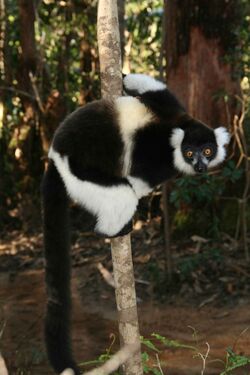Varecia variegata (Black-and-white Ruffed Lemur): Difference between revisions
imported>Lee R. Berger (editing) |
imported>Lee R. Berger (editing) |
||
| Line 1: | Line 1: | ||
[[Image:bwrl1.jpg|thumb|right|300px|A '''Black and white ruffed lemur''', (''Varecia variegata variegata'').{{photo|Lee R. Berger}}]] | [[Image:bwrl1.jpg|thumb|right|300px|A '''Black and white ruffed lemur''', (''Varecia variegata variegata'').{{photo|Lee R. Berger}}]] | ||
The '''Black and white ruffed lemur''' ''Varecia variegata variegata'' is a large quadrupedal[[Lemur]]. In the wild, it is found only on the island of [[Madagascar]]. | The '''Black and white ruffed lemur''' ''Varecia variegata variegata'' is a large quadrupedal [[Lemur]]. In the wild, it is found only on the island of [[Madagascar]]. | ||
==Description== | ==Description== | ||
Revision as of 04:39, 6 September 2007

The Black and white ruffed lemur Varecia variegata variegata is a large quadrupedal Lemur. In the wild, it is found only on the island of Madagascar.
Description
The Black and white ruffed lemur is a diurnal Primate that has a head body length of approximately 43 – 57 cm and a tail length of around 60-65 cm[1][2][3]. Weight ranges between approximately 3 and 3.5 kg[3]. Coat color, as the ocmmon name suggests, is black and white. [3]. The coat and tail are fluffy and the black and white ruffed lemur has prominent "tuffs" on the ears[3]. There are no size or color differences that distinguish males from females.
Behaviour
Studies show significant variation in group size and territorial behaviour [2][3]. The black and white ruffed lemur moves mostly quadrupedally but is also an adept leaper[3]which can be reminiscent of the singing of some whale species.It has been noted that this species is possibly the only Primate to build nests exclusively for the birth of young[3].
Diet
It is highly frugiverous but also eats seeds, leaves and nectar [2][3].
Geographical distribution
The black and white ruffed lemur may be found in small areas of tropical moist lowland and montane forests of eastern Madagascar[3].
Status
The black and white ruffed lemur is considered to be critically endangered by the IUCN.
External links
References
- ↑ J. Fleagle (1998). Primate Adaptation and Evolution. Academic Press: New York.
- ↑ 2.0 2.1 2.2 F. Szalay and E. Delson (2001). Evolutionary History of the Primates. Academic Press, New York.
- ↑ 3.0 3.1 3.2 3.3 3.4 3.5 3.6 3.7 3.8 3.9 Mittermeier et al. (2006). Lemurs of Madagascar. Conservation International.
